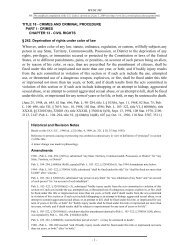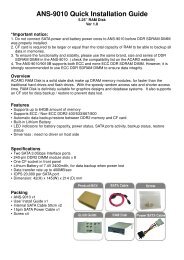2004 Instructions for Form 1040 (ALL) - Supreme Law Firm
2004 Instructions for Form 1040 (ALL) - Supreme Law Firm
2004 Instructions for Form 1040 (ALL) - Supreme Law Firm
You also want an ePaper? Increase the reach of your titles
YUMPU automatically turns print PDFs into web optimized ePapers that Google loves.
positive amount on line 1 of the 2001 work- lines 25 and 39, or on the Schedule D Tax return, if later), even if you did not file a tax<br />
sheet. Worksheet, lines 15 and 36). return <strong>for</strong> 2002.<br />
When John filed his 2001 tax return, he Exception. You must use the 2001 Tax <strong>Instructions</strong> <strong>for</strong> 2002 Taxable<br />
had a $3,000 net capital loss deduction on Computation Worksheet <strong>for</strong> Certain De- Income Worksheet<br />
Schedule D, line 18 (which was also en- pendents and Nonresident Alien Individuals<br />
on page J-3 if you, or your spouse if<br />
Line 2. Any net capital loss deduction on<br />
tered on <strong>Form</strong> <strong>1040</strong>, line 13), a $7,000 loss<br />
filing jointly, did not receive (be<strong>for</strong>e offset)<br />
your 2002 Schedule D, line 18, is not al-<br />
on Schedule D, line 17, and a $4,000 capilowed<br />
<strong>for</strong> income averaging purposes to the<br />
an advance payment of your 2001 taxes and<br />
tal loss carryover to 2002. However, when<br />
either of the following apply.<br />
extent it did not reduce your capital loss<br />
John carried back the 2002 NOL to 2001,<br />
carryover to 2003. This could happen if the<br />
he refigured his 2001 capital loss carryover • You, or your spouse if filing jointly, taxable income be<strong>for</strong>e subtracting exempto<br />
2002 as $7,000. John adds the $3,000 could be claimed as a dependent on some- tions shown on your 2002 <strong>Form</strong> <strong>1040</strong>,<br />
from Schedule D, line 18, and the $7,000 one else’s 2001 tax return. line 39 (or as previously adjusted), was less<br />
carryover. He subtracts from the result the • You filed <strong>Form</strong> <strong>1040</strong>NR <strong>for</strong> 2001. than zero. Enter the amount by which your<br />
$7,000 loss on his Schedule D, line 17, and<br />
If the 2001 Capital Gain Tax Worksheet<br />
2002 capital loss carryover to 2003 (the<br />
enters $3,000 on line 2 of the worksheet.<br />
or Schedule D also applies, follow the Speloss<br />
carryovers) exceeds the excess of the<br />
sum of your short- and long-term capital<br />
John had $1,000 of taxable income in cial Rules on the worksheet on page J-3 to<br />
2001 that reduced the 2002 NOL car- figure your tax.<br />
loss on your 2002 Schedule D, line 17, over<br />
ryback. The $2,900 of exemptions and<br />
the loss on your 2002 Schedule D, line 18.<br />
$3,000 net capital loss deduction also resure<br />
you refigured your 2002 capital loss<br />
If you had any NOL carrybacks to 2002, be<br />
duced the amount of the 2002 NOL carcarryover<br />
to 2003.<br />
ryback. There<strong>for</strong>e, only $2,100 was Line 9<br />
available to carry to 2003 and later years, as If you used Schedule J to figure your tax <strong>for</strong> Line 3. If you had an NOL <strong>for</strong> 2002, enter<br />
shown on his 2002 <strong>Form</strong> 1045, Schedule B, 2003 (that is, you entered the amount from the amount of that NOL as figured on the<br />
line 9. John enters the $2,100 on line 3 of that Schedule J, line 22, on <strong>Form</strong> <strong>1040</strong>, 2002 <strong>Form</strong> 1045, Schedule A, line 27, you<br />
the worksheet, and $5,100 on line 4. He line 41, or on <strong>Form</strong> <strong>1040</strong>X), enter on line 9 filed with <strong>Form</strong> 1045 or <strong>Form</strong> <strong>1040</strong>X. If<br />
then subtracts the $5,100 from the $8,000 the amount from your 2003 Schedule J, line you did not have an NOL <strong>for</strong> 2002, enter<br />
on line 1 and enters the result, $2,900, on 15. If you used Schedule J to figure your the portion, if any, of the NOL carryovers<br />
line 5 of the worksheet. He enters a nega- tax <strong>for</strong> 2002 but not 2003, enter on line 9 and carrybacks to 2002 that were not used<br />
tive $2,900 on Schedule J, line 5. He com- the amount from your 2002 Schedule J, line in 2002 and were carried to years after<br />
bines that amount with the $6,000 on 3. 2002.<br />
Schedule J, line 6, and enters $3,100 on<br />
Schedule J, line 7.<br />
If you figured your tax <strong>for</strong> both 2002 Example. John Farmington did not use<br />
and 2003 without using Schedule J, enter income averaging <strong>for</strong> 2001, 2002, nor<br />
on line 9 the taxable income from your 2003. The taxable income be<strong>for</strong>e sub-<br />
2002 tax return (or as previously adjusted tracting exemptions on his 2002 <strong>Form</strong><br />
Line 8<br />
by the IRS, an amended return, etc.). But if <strong>1040</strong>, line 39, is a negative $30,000. A de-<br />
that amount is zero or less, complete the duction <strong>for</strong> exemptions of $3,000 is shown<br />
If line 7 is zero, enter -0- on line 8. Otherworksheet<br />
below to figure the amount to on line 40, and line 41, taxable income, is<br />
wise, figure the tax on the amount on line 7<br />
enter on line 9.<br />
limited to zero. John subtracts from the<br />
using:<br />
$30,000 loss the $3,000 deduction <strong>for</strong> ex-<br />
If you filed your 2002 tax return using<br />
• The 2001 Tax Rate Schedules on<br />
emptions. The result is a negative $33,000,<br />
TeleFile, enter the taxable income from<br />
page J-2,<br />
John’s 2002 taxable income, which he en-<br />
your TeleFile Tax Record. If you did not<br />
• The 2001 Capital Gain Tax Work-<br />
ters as a positive amount on line 1 of the<br />
file a tax return <strong>for</strong> 2002, use the amount<br />
sheet on page J-3, or<br />
2002 worksheet.<br />
you would have reported as your taxable<br />
• The Schedule D you filed <strong>for</strong> 2001 income had you been required to file a tax John had a $3,000 net capital loss de-<br />
(but use the 2001 Tax Rate Schedules on return. Be sure to keep all your records <strong>for</strong> duction on Schedule D, line 18 (which was<br />
page J-2 instead of the 2001 Tax Table 2002 until at least 3 years after April 15, also entered on <strong>Form</strong> <strong>1040</strong>, line 13), and a<br />
when figuring the tax on Schedule D, 2005 (or the date you file your <strong>2004</strong> tax $7,000 loss on Schedule D, line 17 (as ad-<br />
2002 Taxable Income Worksheet—Line 9 Keep <strong>for</strong> Your Records<br />
Complete this worksheet if you did not use Schedule J to figure your tax <strong>for</strong> 2003 and your 2002 taxable income was zero or<br />
less. See the instructions above be<strong>for</strong>e completing this worksheet.<br />
1. Figure the taxable income from your 2002 tax return (or as previously adjusted) without limiting it<br />
to zero. If you had an NOL <strong>for</strong> 2002, do not include any NOL carryovers or carrybacks to 2002.<br />
Enter the result as a positive amount ............................................... 1.<br />
2. If there is a loss on your 2002 Schedule D, line 18, add that loss (as a positive<br />
amount) and your 2002 capital loss carryover to 2003. Subtract from that sum<br />
the amount of the loss on your 2002 Schedule D, line 17, and enter the result . . 2.<br />
3. If you had an NOL <strong>for</strong> 2002, enter it as a positive amount. Otherwise, enter as a<br />
positive amount the portion, if any, of the NOL carryovers and carrybacks to<br />
2002 that were not used in 2002 and were carried to years after 2002 ........ 3.<br />
4. Add lines 2 and 3 ............................................................. 4.<br />
5. Subtract line 4 from line 1. Enter the result as a negative amount on Schedule J, line 9 .......... 5.<br />
J-4













